#biblical king of the south
Explore tagged Tumblr posts
Link
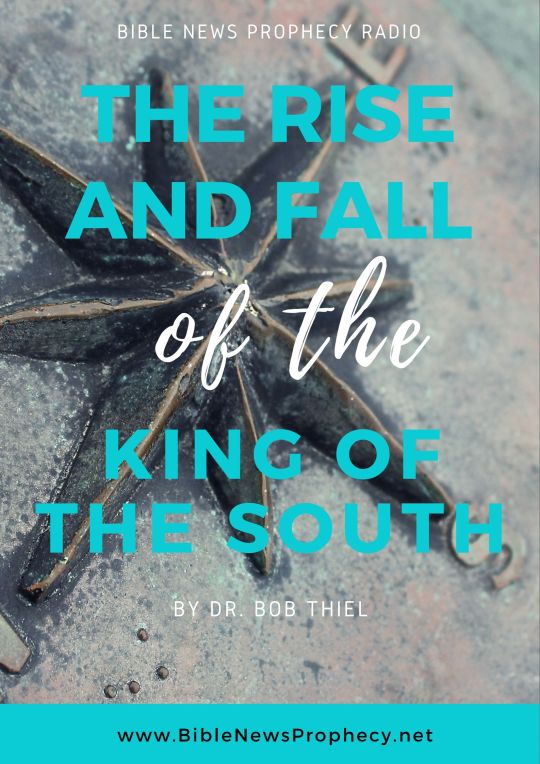
#rise of the king of the south#fall of the king of the south#king of the south#Daniel 11#bible prophecy#Psalm 83#daniel 9:26-27#peace deal#prophesied king of the south#daniel 11:27#Ezekiel 30:1-9#Jeremiah 46:14-24#saudi arabia military coalition#north africa & middle east#biblical king of the south#end time prophecy#muslim prophesies#biblical prophesies#great arab#imam mahdi#the coming king of the south#arab coalition
0 notes
Text

3,000-year-old artifact inscribed with earliest mention of the House of King David found in Israel provides archaeological evidence for the foundational narratives of three monotheistic faiths.
The Tel Dan Stele, a 9th century BCE stone monument fragment, containing the earliest mention of the royal House of David outside of the Hebrew Bible, will be on view at the Jewish Museum for a limited time. On loan from The Israel Museum, Jerusalem, the stone slab's inscription lends archaeological evidence to the existence of the Biblical King David as a historical figure, in parallel with the narrative of the Bible.
Discovered in northern Israel in the early 1990s, the Stele—an archaeological term for an upright monument used in ancient cultures to commemorate a person, place, or event—was once part of an inscription on a basalt victory Stele commemorating the military victories of King Hazael of Aram (a region in present-day Syria) between c. 842 and 806 BCE. Although Hazael’s name is not cited in the inscription, scholars believe him to be its author.
In the inscription, the Aramaic king boasts that he defeated King Jehoram of Israel and King Ahaziahu of Judah, a reference to Israel’s two kingdoms at the time, Israel in the north and Judah in the south, the latter also commonly known as the House of David. The engraved inscription’s mention of a “king of the House of David,” is a direct reference to ancient Israel’s monarch and his royal dynasty, corresponding with the Bible’s historical narrative.
The first fragment comprising the Stele was unearthed in July 1993, during excavations of an ancient stone wall in Tel Dan, Israel. The following year, two additional fragments were discovered at the same site and linked to the original fragment.
Building on the archaeological evidence of King David’s reign in Israel, the Tel Dan Stele will be exhibited alongside five late 8th century BCE handles stamped with royal seals, once part of large clay storage jars, from the Jewish Museum’s archaeology collection. The seals on these fragments are inscribed “[Belonging] to the king” in ancient Hebrew, attesting to the existence of kingship in ancient Israel. The jars were likely part of a royal provisioning system. Three of the jar handles cite the city of Hebron in their royal seal impressions, and two mention the city of Socoh in the ancient kingdom of Judah.
The Tel Dan Stele is presented within Engaging with History: Works from the Collection, a selection of rarely exhibited objects from the Museum’s holdings of over 30,000 works including new acquisitions by Carrie Mae Weens, William Kentridge, and others on view for the first time in dialogue with Museum treasures reflecting millenia of global Jewish culture.
The presentation of the Tel Dan Stele was initiated by James S. Snyder, Helen Goldsmith Menschel Director, in collaboration with Dr. Haim Gitler, Tamar and Teddy Kollek Chief Curator of Archaeology at The Israel Museum, Jerusalem.
This installation is made possible with generous support from the Armstrong International Cultural Foundation, in collaboration with the Jerusalem-based Armstrong Institute of Biblical Archaeology, The Israel Museum, and the Israel Antiquities Authority.
57 notes
·
View notes
Text

Ethiopia is unique in the way of being Jewish before it was Christian. There are several theories as to how exactly this happened - some swear by the legend of King Solomon and Queen Sheba giving a start to a dynasty of Jewish kings; others, among them some of the more prominent Biblical historians, believe that an Israelite tribe, or tribes, migrated south via Egypt following the destruction of the first Temple. Either way, when Christianity did arrive in Ethiopia, it grafted itself not on paganism, as in almost every other part of the world, but on Judaism, which led to the formation of a church very closely associated with its Jewish sources (as the Ethiopian church remains to this day).
According to the Beta Israel tradition, the Jewish kingdom of Beta Israel, later called the kingdom of Gondar, was initially established after Ezana was crowned as the Emperor of Axum in 325 CE. Ezana, who was educated in his childhood by the missionary Frumentius, declared Christianity as the religion of the Ethiopian empire after he was crowned. The inhabitants who practiced Judaism and refused to convert to Christianity began revolting; this group was referred to as "Beta Israel" by the emperor. Following civil war between the Jewish population and the Christian population, the Beta Israel appear to have forged an independent state, either in northern western Ethiopia or the eastern region of Northern Sudan.
The Golden Age of the Beta Israel kingdom took place, according to the Ethiopian tradition, between the years 858–1270, in which the Jewish kingdom flourished. During that period, the world Jewry heard for the first time the stories of Eldad ha-Dani, who either visited the kingdom or heard many accounts of it in his own Jewish kingdom of pastoralists. Even Marco Polo and Benjamin of Tudela mention an independent Ethiopian Jewish kingdom in the writings from that period.
#jumblr#jewish#jews#judaism#nesyapost#jewish culture#jewish history#beta jews#ethiopian jews#ethiopia#if you know the source of this art please tell me i tried to find the source and could not!!!!
330 notes
·
View notes
Text
Yogirt x Satan Ship Name Brainstorm Post! All Ideas Welcome!
(Please keep it respectful of others)
Alright, fellow shippers! We're at an important point in shipping history: a new fan ship from a major show has appeared! It has no official ship name yet, very few works of art, fanfiction or theories. That's why I'd like to start the ball rolling on brainstorming ship name ideas.
I've already seen a few popping up, such as HellthCare and DragonFruit, but I'd love to come up with a few more choices just to see if another name may fit a bit better.
Of course, I'm in no way an authority in what anyone chooses to call something they enjoy and I'm not trying to force anything. Just throwing out some fun ideas and opening the floor for others to do the same :)
Let's dive in!
🔥❤️��💪🤟🙏🪻🪷🌋🌡️🐦🔥🌶️🍛🎸🕯️🧱🧿🪬📿🔮♨️
A few things to remember about this ship is that:
Both characters have a size and power differences.
Yogirt is calm and Satan is quick to anger.
Both have fire in their designs (Yogirt's candle and Satan's fire powers).
One is a king and one is an advisor.
They both have color schemes of red. Satan has more gold accents and Yogirt can have black, white or pink accents at different times.
Satan is very muscular and Yogirt is very petite.
Yogirt has a food name.
Satan is the primary name of the biblical Devil so many of those titles and attributes could apply
Different aspects of meditation, mindfulness, horoscopes, smells, etc. could be applied to their ship name
Satan is American South coded
Yogirt wears robes and Satan wears an outfit that bikers or "tough guys" would wear
Satan is a judge
Some names I've been thinking about are: Yotan, Sagirt, SoothingSpice, FireFly, ChakraCheck and KingsCouncil.
I'd love to hear your ideas in the comments, tags or in my inbox!
Happy brainstorming!

#helluva boss spoilers#helluva boss season 2 episode 11#helluva boss s2 ep11#spoilers#new characters#yogirt#satan#helluva boss yogirt#helluva boss satan#ship name#spoiler#yogirt x satan prompts#yogirt x satan#satan x yogirt#brainstorm#fandom#dragon#demon
38 notes
·
View notes
Text
The Birth Locations/Suitcase Reveal Sucks
before you read please don't take this too seriously, I don't have a problem with people who enjoy this reveal I just wish more people would consider/analyse this as I feel like it's very half-assed and not at all well thought out
I know I've written something like this before and i'm sorry to write this again, but I think my arguments have developed and I want to explain better why I hate this decision.
I am referring to this set of posters for season 3
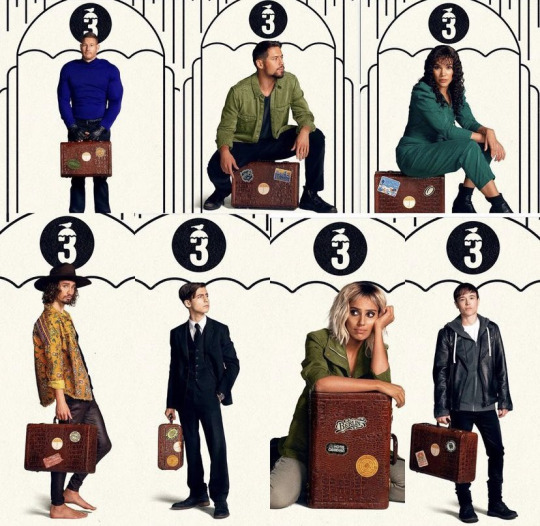
as the stickers on the suitcases were revealed to be their birth locations by Jeff King (executive producer and director) on instagram


the actual answer to his question is "lila's sticker" but semantics/specifics who cares (me)
why I distrust the theory/trivia as a whole
something I think should be considered here is that this is the only confirmation of this piece of trivia.
another example of TUA trivia that has been confirmed by the creators is the statement by Blackman (god ik just ignore that part for now, that isnt the point of the post & he's still a/the creator) on a reddit AMA that Grace helped the siblings choose their names based on their birth countries

however, these are both poorly researched/prepared pieces of trivia because they blatantly contradict each other
Luther's birthplace is Sweden, but Luther isn't a Swedish name, nor was is popular in either 1989 when he was born or 2002 when he was first seen using his name.
Diego is always a fairly popular name in Spanish speaking countries like Mexico but it's hardly high on the list (only statistic I can find is ranked at 31.)
Allison is neither a South African name nor is it listed as it's top names.
Klaus is Germanic (kinda fits the theme) but as far as I can see Klaus is not a biblical name which is much more typical of the Amish. Klaus is also not listed amongst the top Amish names that I've seen.
Five obviously is an outlier here.
Ben is clearly not Korean, and while I have had fun discussing the roots of his name with others (Jae-min becoming Benjamin, and Bin becoming Ben) I don't think that there's any way that the creators will acknowledge this. Ben has origins in Hebrew and is not at all popular in Korea.
Vanya (the applicable name, as Viktor wasn't yet revealed) is a male name in Russia. it's female in other countries like Bulgaria, but not Russia. It's a nickname/evolution of the name Ivan. Vanya is also not a popular name in Russia, but Ivan does seem to be. And I seriously doubt that they're going to reveal that Viktor originally named himself Ivan while he was identifying as female and then decided to change his name anyway?
which is to say, the word of the creator cannot always be trusted/believed, because that's not necessarily what will be reflected in canon or by the other creators.
there is quite a history in fandom of creators not understanding the themes/plotholes of their own creations, so i'm a little stunned at how quickly everyone integrated this into their canon without a second thought.
i have arugments as to why these locations are bad choices for the characters, but first lets take a look at what i believe these stickers were meant to represent
Placing down a read more because this became huge.
what the other stickers reference/mean
it's no secret that i think the stickers were hints to the events (related to each character's arc) of season 3.
but before i get to that let's breakdown the rest of the stickers and their meanings:
all of the umbrella's have an umbrella sticker. Lila is the only one who doesn't (so if we're playing the "who is the odd one out" game then it still falls as Lila because she is the only one without the umbrella sticker)
Luther
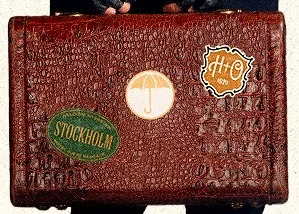
Luther dies in Hotel Obsidian, and never makes it physically inside Oblivion or has any part in powering it - so his sticker has the colours/design of Obsidian.
Diego
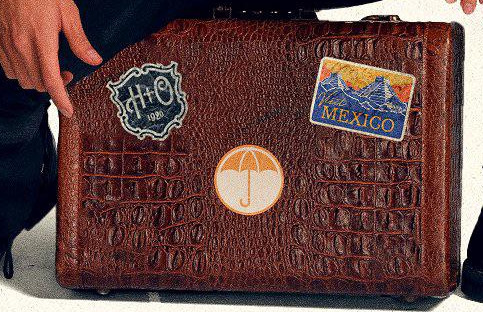
Diego is one of/the first to discover Hotel Oblivion, so he has the Oblivion colours and logo.
Allison
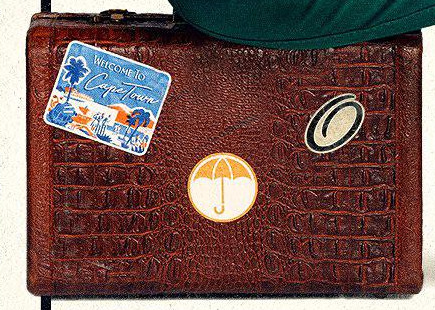
Allison is involved in Reginald's plot to use Oblivion to reset thte universe, so gets Oblivion's logo instead of Obsidian.
Klaus

Klaus was the one to know and direct them to Hotel Obsidian, so he has that logo.
Five
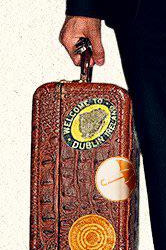
Five's revelation that he was the Founder of the Commission, and the impact of that discovery, links him to the Commission more so than either hotel.
Viktor

viktor has the hotel Obsidian logo because he has very little impact on anything to do with Oblivion and is one of the votes that decides to remain and die in Obsidian.
Lila
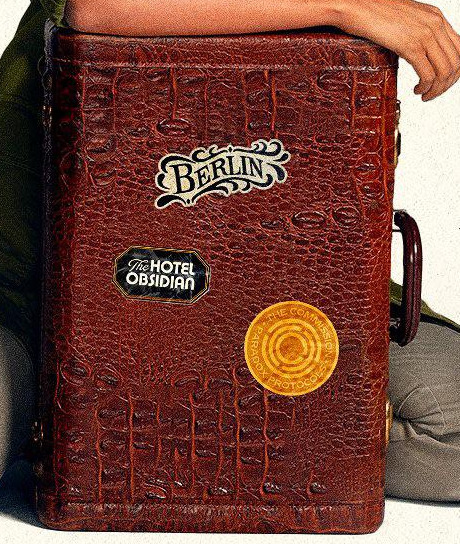
Lila has the Commission because she was raised in the Commission, not the Umbrella Academy.
Lila has the Obsidian logo in opposition to Diego's Oblivion logo as she chooses the opposite of Diego (I personally believe they should have swapped these two but..)
why the birth locations are more likely/appropriate as hints for the events of season 3
Luther - Stockholm, Sweden
This is probably my strongest argument: He is made fun of for having "Stockholm Syndrome" within the show


found: Season 3, episode 3, minute 13.
Luther, obviously spends all of his character development/moments with the Sparrows and Sloane - being kidnapped by them and developing "Stockholm Syndrome" for Sloane (romantic) and for the Sparrows as a whole (platonic/idealism/escapism)
Luther's mother's newpaper cutting also mentions 911 being called, but 911 is not the emergency number of Sweden, 112 is. Argentina, Canada, Dominican Republic, Jordan, Mexico, Pakistan, Palau, Panama, the Philippines, Sint Maarten, the United States, and Uruguay use 911 but not Sweden.
If Monica wasn't in Sweden at the time of Luther's birth, then Stockholm is hardly his birth location.
throughout the seasons we get a few instances of Diego, Ben and Viktor speaking their native languages, hinting that the 7 were all taught their mother's languages (with Allison at least likely learning all 7)
But if Luther is Swedish, why didn't he or Diego know what Oga For Oga meant if that's Luther's mother's language? and why was Five the only person who seemed to understand Swedish when he's not the Swede of the family? Why did Diego not at least recognise his brother's supposed second language? Or Luther for that matter?
Luther was a part of the Academy for 23+ years, longer than anyone, yet Reginald (who expects the best of his children) didn't bother enforcing this as a part of his education? his number one had a worse education than his number 2, 3, 4, 5, 6, and 7?
Diego - Mexico
Diego apparently doesn't even get the luxury of a city, place or region. But I can confirm that his mother's newspaper cutting states that he was born in a "small town in Northern Mexico".
However, Diego's sticker could instead be a reference to the Aztecs or Mayans - his sticker has mayan/aztec pyramids on it, I believe maybe Chichen Itza specifically?? Ancient civilisations that were very advanced for their time, and that are somewhat frequently involved in alien conspiracies.
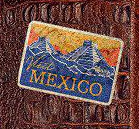
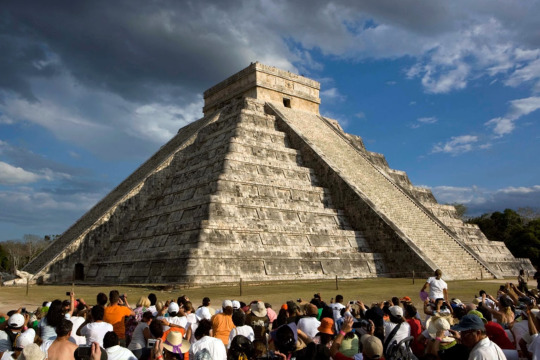
Diego is one the one to open Oblivion when he removes the harpoon, and is the first to enter it and confront the Guardians.
Oblivion is an Ancient building/place built by an Ancient civilisation of what is assumed to be aliens, and Reginald (confirmed alien) is the one to have directed them into Oblivion at first as well.
Allison - Cape Town, South Africa
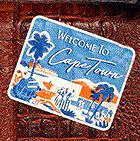
Nelson Mandela is pretty famous for his part in the anti-apartheid (segregation) movement, helping to end segregation in South Africa. He was jailed in a Cape Town prison for attempting to sabotage the pro-segregation government, and then later his office as president was located in Cape Town.
an easy connection to make with Allison's arc in season 2, and the significance of it in her arc in season 3, with her dealing with PTSD, grief over Ray, and feeling alienated by her family who didn't have the same experience as her in the 60s.
Allson's mother has nothing connecting her to South Africa outside of this, as far as I'm aware.
Klaus - Pennsylvania, USA

This one I will concede is about his birth location. But in this case, it's also heavily related to his season 3 arc, as he is the driving force of the mothers plotline and literally travels to Pennsylvania.
PA is a strong and relevant hint for his s3 arc.
Five - Dublin, Ireland

Five could be connected to Ireland in multiple ways.
(there is a link between Five and JFK, "the 1st Irish American President" but I can't see the link to s3 here so honorary mention only).
A link that I understand is a somewhat touchy topic for any Irish citizens is the stereotype of drunkeness in Ireland. While there have been studies to prove that Ireland doesn't drink more than other countries such as England, it remains a well-known stereotype and the Irish people are statistically more prone to alcohol dependency/addiction.
There is also the phrase "make it Irish" which means to put alcohol in a drink, one of the more popular drinks to do this to is coffee. Which brings us back to Five - he is known for his love of coffee and for getting spectacularly drunk.
season 3 in particular features his drinking addiction in it's full glory. it's also plot relevant as his drunkness causes the murder mystery setup of the final episodes.
(also, while it's not great to have Ireland be the hint to alcohol, it's also not great to have Five, the alcoholic of the series, be the Irish representation)
Another interpretation could be the root of the name "Dublin" meaning "black pool". It was likely derived from the River Poddle which would have been stained black with peat. This could be a hint towards Five's elusive role as the Founder, as his life so far has been stained with childhood abuse, the apocalypse and his foray as an assassin, making the reveal of the Founder a shock.
One other interpretation is the Irish vs. English. Five is perhaps the most skeptical of Reginald throughout season 3, moreso than even Luther or Diego. While England has enraged many countries, Ireland is one of the most well known for it's dislike of the English, and has a lengthy history of war and altercations with England. So Five's sticker may be a hint for his re-ignited distrust of Reginald. It also works well as a predictor for Five and Lila's (English) bathroom fight.
Five's mother's newpaper cutting has several contradictions to the Ireland, Dublin location. First and foremost being that she is cited as being from both a "small seaside community" and from "county clark".
There is no County Clark in Ireland, but there is a County Clare and a County Cork. However, County Clare is on the opposite side of Ireland to Dublin and County Cork is even farther away,
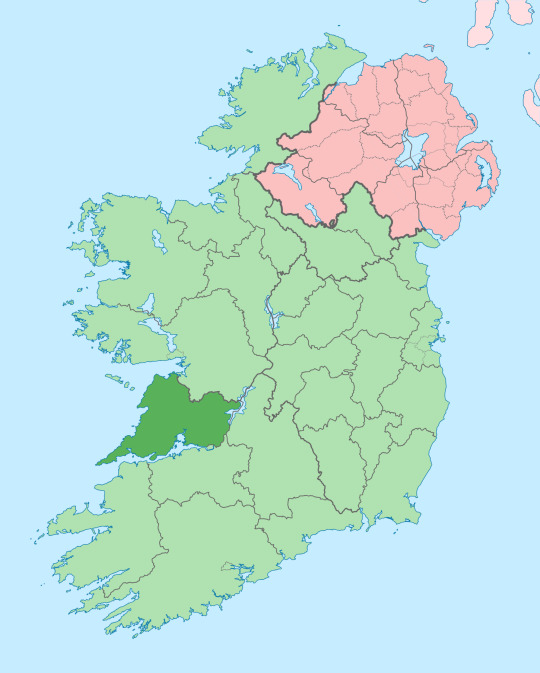
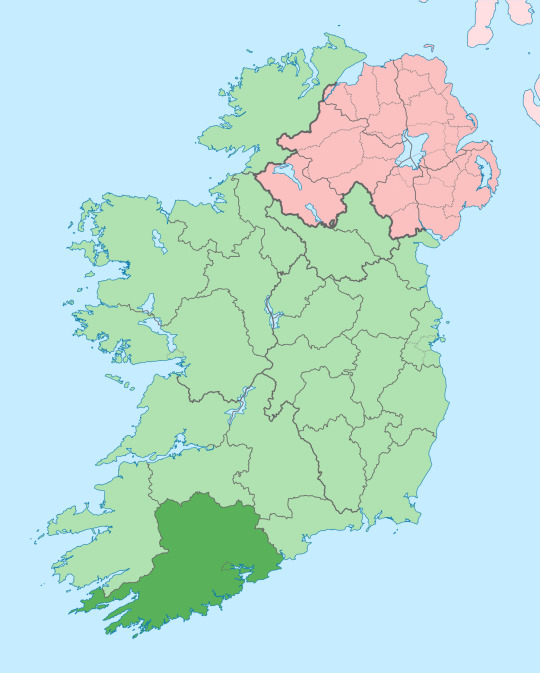

Dublin, as the Capital City, is also not a "small seaside community" by any stretch of the imagination.
And the Irish police would likely not be referred to as "provincial" but instead be called Gardaí or The Garda Síochána.
Viktor - Moscow, Russia

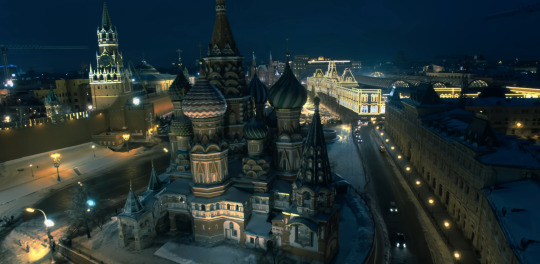
Moscow is seen in season 1, episode 1 very briefly as Reginald arrives to adopt Viktor. You can see both the Spasskaya Tower and St Basil's Cathedral. Viktor also speaks Russian, something that none of his siblings have demonstrated.
However, this is not actually Viktor's birthplace (if we believe that the props have canon information, as most argue that Diego is definately from Mexico due to his cutting stating his mother was in Northern Mexico, etc) as according to his book Viktor was born in "small town off the Southern coast of Russia".
Moscow is nowhere near the coast and is not exactly southern either, nor is it a small town. And while this isn't exaclty specified that the "small town" he visits is the place he was born, it wouldn't make much sense if it wasn't, as Viktor was able to track his mother down via newspaper articles about his birth.
Moscow could mean a lot of things for Viktor's arc:
it could be a reference to s1, ep1 but instead of his exact birth location, it could simply hint to his mother's country and toward Harlan's involvement in the mothers' deaths - and the long reach of his powers from America to Russia.
It could also be a hint to Viktor's significance as a much more involved and aware plot driver this season as Moscow is the politcal centre of Russia as its capital city.
It might also hint at his disconnect from his family (not being a part of the Academy and not understanding the hard decisions and necessary teamwork that come with it) causing tensions, as while Moscow is the political capital, Saint Petersburg is considered the cultural capital.
Plus Moscow's history as the capital works well as a parallel to his journey with his powers, and works as a hint to Viktor developing his powers with Harlan because Moscow also briefly lost its status as the capital to Saint Petersburg, possibly a parallel to Viktor, the most powerful of the Umbrellas, losing his powers to Reginald's drugs. Moscow was later restored as the capital, paralleling Viktor's regaining of his powers.
Lila - Berlin
Lila is nice and simple, she was considered the outlier by Jeff King anyway as her suitcase doesn't match her confirmed birth place (London), and instead is a pretty obvious hint to her time in West Berlin, Germany, with Trudy and Stan.
why i dislike the chosen locations as the birth locations
in general I think it's silly to choose almost all capital cities: Dublin, Moscow, Cape Town, Stockholm, Seoul..
I know these are populous places but there must have been some variation? (aside from Klaus, who has plot armour for this point due to his Amish origins, and Diego, who is the only non-capital city purely because he wasn't given the dignity of a named city/town/village)
it's also lazy writing (and i believe somewhat racist?) to have every sibling come from the country/continent you'd expect?
the latino is mexican
the black woman is african
the asian man is asian
the blonde haired/blue eyed man is scandinavian
even Klaus, Five and Viktor are all white men from predominantly white countries.
at least try to subvert expectations?
to an extent i understand that they were trying to incorporate the actors ethnicities with Justin having korean roots, and David being raised in mexico. But the only irish thing about Aidan is his surname, and Emmy has no known connection to South Africa. I'm also pretty sure Tom isn't swedish at all and Elliot isn't russian.
it's lazy, poorly planned and honestly highly questionable writing at best
#tua#the umbrella academy#luther hargreeves#diego hargreeves#allison hargreeves#klaus hargreeves#five hargreeves#viktor hargreeves#lila pitts
44 notes
·
View notes
Photo

Caesarea Maritima's Role in the Mediterranean Trade
Caesarea Maritima was located on the eastern coast of the Mediterranean Sea. Built from the ground up in 22-10 BCE by Rome's client king, Herod the Great (r. 37-4 BCE), its location in relation to ship traffic and proximity to historical trade routes indicates a purposeful plan to capture income, making Caesarea a commercial gateway to the West.
Roman Harbor Scene
Carole Raddato (CC BY-SA)
Major Players
The context for Caesarea's existence lies in Rome's rivalry with Parthia: Rome's ablest competitor. With the defeat at the Battle of Carrhae, 53 BCE, and retreat from Media in 36 BCE, the failure to take Parthia's lucrative northern silk routes through Mesopotamia caused Rome to sue for peace in 20 BCE. As a result, Rome's efforts to round out its dominance in the Mediterranean Sea and the Near East took on a commercial tone. In an attempt to control the lucrative southern east/west trade routes through Arabia and the Red Sea, Caesarea would serve as the springboard. As a key hub in the Eastern trade network of ancient Rome, Caesarea's connections to major players in the early centuries of the first millennium would include Gaza, Petra, Sidon, Tyre, Alexandria, and consumer cities like Bostra. Further afield were the commercial centers of Antioch and Patara.
As a major commercial center in the northern areas of the Mediterranean, Antioch benefited from its location at the western terminus of the Silk Road of Mesopotamia. Besides being a major center of wine and olive oil production and the fulling of cloth products, Antioch played a major role in the distribution of silk from China, lapis lazuli from ancient Afghanistan, dye-works from the Levant, and weaved silk from Damascus.
West of Antioch, on the southern coast of Anatolia (modern-day Turkey), was the coastal city of Patara, providing export service. As evidence for the traditional production of agricultural goods and animal husbandry in Anatolia reaches back to the first centuries of the 2nd millennium BCE, the production of Anatolian copper, gold, silver, iron, and lead was documented by Pliny and Strabo. As James Muhly adds:
Anatolia is a land blessed with abundant natural resources, including a wealth of mineral deposits and abundant forests, the two elements necessary for a major metal industry. Recent calculations provide the following figures: 415 major copper-rich zones, more than 136 complex lead-zinc-copper ore deposits, and almost 200 silver-lead deposits, as well as numerous deposits of gold, zinc, antimony, arsenic, and iron. (858-59)
Modern surveys also confirm that, from 3000 BCE to the Ottoman period, Anatolia was an important producer of copper and possibly tin, essential ingredients of bronze.
Then, sharing the eastern coast of the Mediterranean are the two Phoenician city-states of Sidon and Tyre. As Caesarea was built over the ruins of Straton's Tower - named after King Straton I (r. 365-352 BCE) of Sidon - Strabo reports it had its own "station for vessels" (16.2.27). With its location in the midst of shipping and trade routes north of Alexandria and 120 km between Gaza and Sidon, Straton's Tower reflects Sidon's scale of commercial influence. Once providing ships and goods for Persia, Sidon was also an important manufacturer of luxury goods such as glass, dyes, and embroidered garments. Just south of Sidon, the island of Tyre was also a commercial powerhouse. Besides its famous purple-dyed cloth, according to the biblical account in 1 Kings 7:13-45, Solomon sought help from Tyre to manufacture and furnish bronze finished products for the temple.
Roman Rule in the Levant, c. 200 CE
Simeon Netchev (CC BY-NC-ND)
Though their spheres of commercial influence were reduced with the control of the Phoenician coast by the Seleucid Empire (312-63 BCE), then by the Romans, Sidon, and Tyre would continue to play a part in the overall network of trade in the Eastern Mediterranean. Conversely, while Tyre and Sidon were known for their finished products, west of the Nile on the northern coast of Africa, Alexandria shipped goods from Egypt. Besides the bulk manufacturing and export of textiles and papyrus, with Rome as its main consumer, Egypt commonly shipped its oil and grain products aboard the famous Alexandrian ships. One such ship, the Isis, as described by Lucian, had a length of 55 meters (180 ft) and a beam of 14 meters (45 ft); with a cargo hold depth of 13.5 meters (44 ft), it could carry 1200 tons of product.
Finally, within Caesarea's direct orbit were the important cities of Gaza, Petra, and Bostra. Gaza served as a conduit to Western markets, receiving goods from Africa, Arabia, India, and Indonesia, the most lucrative of which would have been pepper and frankincense. Gaza was one of the first cities to come under Caesarea's direct control when Augustus (r. 31 BCE to 14 CE) granted it to Herod in 30 BCE. However, as the Nabateans of Petra were major traders and middlemen for goods coming from the East through Arabia and the Red Sea by way of their port Leuce, Roman interest in Gaza, Petra, and Red Sea connections would be fully realized when the Roman emperor Trajan (r. 98-117 CE) annexed the Nabatean Kingdom as the Provincia Arabia in 106 CE. In addition, important consumer cities within Caesarea's regional neighborhood would include Jerusalem, Samaria, and Bostra. For Rome – perhaps to cut out Nabatean middlemen – Bostra's commercial importance would be elevated when it later usurped Petra as the trading center of the region to become the Roman capital of Arabia, after which a road was quickly constructed to connect Bostra to the Red Sea.
Continue reading...
26 notes
·
View notes
Text

Kandake, kadake or kentake (Meroitic: 𐦲𐦷𐦲𐦡 kdke), often Latinised as Candace (Ancient Greek: Κανδάκη, Kandakē), was the Meroitic term for the sister of the king of Kush who, due to the matrilineal succession, would bear the next heir, making her a queen mother.

Pliny��writes that the "Queen of the Ethiopians" bore the title Candace, and indicates that the Ethiopians had conquered ancient Syria and the Mediterranean.
In 25 BC the Kush kandake Amanirenas, as reported by Strabo, attacked the city of Syene, today's Aswan, in territory of the Roman Empire; Emperor Augustus destroyed the city of Napata in retaliation.
Cassius Dio wrote that Kandake's army advanced as far as the Elephantine in Egypt, but Petronius defeated them and took Napata, their capital, and other cities.
Four African queens were known to the Greco-Roman world as the "Candaces": Amanishakheto, Amanirenas, Nawidemak, and Malegereabar

Biblical usage
The Baptism of Queen Candace's Eunuch (c. 1625–30, attributed to Hendrick van Balen and Jan Brueghel the Younger)
In the New Testament, a treasury official of "Candace, queen of the Ethiopians", returning from a trip to Jerusalem, met with Philip the Evangelist:
Now an angel of the Lord said to Philip, "Rise and go toward the south to the road that goes down from Jerusalem to Gaza." This is a desert place. And he rose and went. And there was an Ethiopian, a eunuch, a court official of Candace, queen of the Ethiopians, who was in charge of all her treasure. He had come to Jerusalem to worship
He discussed with Philip the meaning of a perplexing passage from the Book of Isaiah. Philip explained the scripture to him and he was promptly baptised in some nearby water. The eunuch 'went on his way, rejoicing', and presumably therefore reported back on his conversion to the Kandake

Evidence outside of Nubia that shows additional links to Kushite's queenship concept are found in Ethiopia. Ethiopia has a long dynastic history claimed to be over three millennia from before 1000 BC to 1973, the year of the overthrow of the last Menelik emperor, Haile Selassie. The Ethiopian monarchy's official chronicle of dynastic succession descends from Menelik I includes six regnant queens referred to as Kandake. The following queens from the king list have "Kandake" added to their name:
Nicauta Kandake (r. 740–730 BCE)
Nikawla Kandake II (r. 342–332 BCE)
Akawsis Kandake III (r. 325–315 BCE)
Nikosis Kandake IV (r. 242–232 BCE)
Nicotnis Kandake V (r. 35–25 BCE)
Garsemot Kandake VI (r. 40–50 CE) – Allegedly the queen who ruled at the time of the Biblical story of the Ethiopian eunuch.
Twenty-one queens are recorded as sole regent in the kingdom of Ethiopia until the 9th century CE. The conquest of Meroe by the Axumite King Ezana may well provide the historical fiction for the Ethiopian dynastic claim to the Nubian Kandakes and their kings, as it was from this point onwards that the Axumites began calling themselves "Ethiopians", a Greco-Roman term previously used largely for the ancient Nubians. For example, Makeda, Queen of Sheba, in the Kebra Nagast, is also recognized as Candace or "Queen Mother".

Alexandrian legend
Jewellery of Kandake Amanishakheto, from her tomb
A legend in the Alexander romance claims that "Candace of Meroë" fought Alexander the Great. In fact, Alexander never attacked Nubia and never attempted to move further south than the oasis of Siwa in Egypt. The story is that when Alexander attempted to conquer her lands in 332 BC, she arranged her armies strategically to meet him and was present on a war elephant when he approached. Having assessed the strength of her armies, Alexander decided to withdraw from Nubia, heading to Egypt instead. Another story claims that Alexander and Candace had a romantic encounter.
These accounts originate from Alexander Romance by an unknown writer called Pseudo-Callisthenes, and the work is largely a fictionalized and grandiose account of Alexander's life. It is commonly quoted, but there seems to be no historical reference to this event from Alexander's time. The whole story of Alexander and Candace's encounter appears to be legendary.
John Malalas has mixed the Pseudo-Callisthenes material with other and wrote about the affair of Alexander with Kandake, adding that they got married. Malalas also wrote that Kandake was an Indian queen and Alexander met her during his Indian campaign

List of ruling kandakes
Pyramid of Amanitore in modern day Sudan
See also: List of monarchs of Kush
At least eleven kandakes also ruled in their own right as monarchs (i.e. queen regnants) of Kush:
Nahirqo (middle 2nd century BC)
An unknown queen regnant (end of the 2nd–first half of the 1st century BC)
Amanirenas (end of the 1st century BC–beginning of the 1st century AD)
Amanishakheto (early 1st century AD)
Shanakdakhete (first half of the 1st century AD)
Nawidemak (first half of the 1st century AD?)
Amanitore (middle 1st century AD)
Amanikhatashan (middle 2nd century AD?)
Amanikhalika (second half of the 2nd century AD)
Patrapeamani [de] (early 4th century)
Amanipilade (mid-4th century)
Based on the reading of a single inscription, some lists give two later kandakes named Maloqorebar (266–283 AD) and Lahideamani (306-314 AD). A recently discovered inscription corrects this earlier reading, however, showing that neither was a woman.

Archaeological sources
The Kandakes of Meroe were first described through the Greek geographer's Strabo account of the "one-eyed Candace" in 23 BCE in his encyclopedia Geographica. There are at least ten regnant Meroitic queens during the 500 years between 260 BCE and 320 CE, and at least six during the 140 periods between 60 BC and 80 AD. The iconographic portrayal of the Meroitic queens depicts them as women often alone and at the forefront of their stelae and sculptures and shown in regal women's clothing. Early depictions of Kushite queens typically do not have Egyptian elements making their appearance drastically different from their Kushite men and Egyptian counterparts. As seen in the Dream Stela of Tanawetamani, a large shawl was wrapped around the body with an additionally decorated cloak worn over the first; typically, a small tab-like element hanging below the hem touches the ground and has been interpreted as a little tail. The first association with this element of dress is with Tarharqo's mother during his coronation ceremony.
It was not until George Reisner excavated the royal cemeteries at El Kurru and Nuri that archaeological material became available to study the Kushite queenship. Additionally, a few royal tombs of Kushite women have been found at Meroe's cemetery and in Egypt at Abydos (Leahy 1994). At El Kurru, six pyramids belong to royal women of the 25th Dynasty and a pyramid for queen Qalhata of the Napatan period. At Nuri, the tombs of royal women are located on the west plateau with more inscriptional information available at the site, linking the roles that the kings' mothers played in succession and their importance during the Kushite dynasty.
The most important event that Kushite women participated in was kingship's ensured continuity, where royal women were mentioned and represented in the royal ceremony. The lunettes of the stelae of Tanawetamani, Harsiyotef, and Nastasen all provide iconographic and textual evidence of these kings' enthronement. In all of these stelae, the king is accompanied by a female member of his family, mother, and wife. The king's mother played an essential role in the legitimacy of her son as the king; textual evidence from Taharqo's coronation stelae represents inscriptional evidence suggesting that the king's mother traveled to her son's coronation. During the Kushite 25th Dynasty, the office that is known as God's Wife of Amun was established. The royal women in this role acted as the primary contact with the Kushite god Amun. They played a decisive role in the king's accession to the throne.
Bas-reliefs dated to about 170 B.C. reveal the kentake Shanakdakheto, dressed in armor and wielding a spear in battle. She did not rule as queen regent or queen mother, but as a fully independent ruler. Her husband was her consort. In bas-reliefs found in the ruins of building projects she commissioned, Shanakdakheto is portrayed both alone as well as with her husband and son, who would inherit the throne by her death.

#african#afrakan#kemetic dreams#africans#brownskin#brown skin#afrakans#african culture#afrakan spirituality#ta seti#north africa#kandake#candace#kemet#nile valley#hapi valley#hapi#east africa#north east africa#Napata#african history#africantumblr#Shanakdakheto#Kushite 25th Dynasty#haile selassie#amun#amun ra#amunet#Kebra Nagast#meroe
30 notes
·
View notes
Text
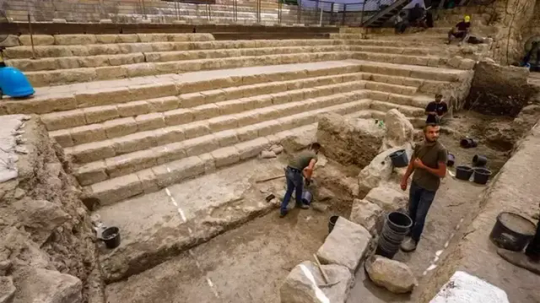
Biblical Steps Where Jesus 'Healed a Blind Man' Unearthed by Archaeologists
In Jerusalem, a recent excavation effort uncovered stairs that had been hidden for more than 2,000 years near the spot where the New Testament says Jesus treated a blind man.
A new excavation project in Jerusalem has unearthed steps unseen in over 2,000 years at a place where the New Testament records Jesus as having healed a blind man.
The Israel Antiquities Authority, the Israel National Parks Authority and the City of David Foundation early this year announced that the Pool of Siloam, a biblical site cherished by Christians and Jews, will be open to the public for the first time in 2,000 years in the near future.

In recent weeks, archeologists achieved significant progress in the excavation, unearthing some eight steps descending into the Pool which had not been seen in 2,000 years — around the time when Jesus walked the Earth.
“The ongoing excavations within the City of David — the historic site of Biblical Jerusalem — particularly of the Pool of Siloam and the Pilgrimage Road, serve as one of the greatest affirmations of that heritage and the millennia-old bond Jews and Christians have with Jerusalem,” Ze’ev Orenstein, director of International Affairs – City of David Foundation said.
“Not simply as a matter of faith, but as a matter of fact,” he added.
The City of David Foundation is a non-profit organization established in 1986, “dedicated to the preservation and development of the City of David and its environs, and is committed to connecting people of all faiths and backgrounds to ancient Jerusalem.”

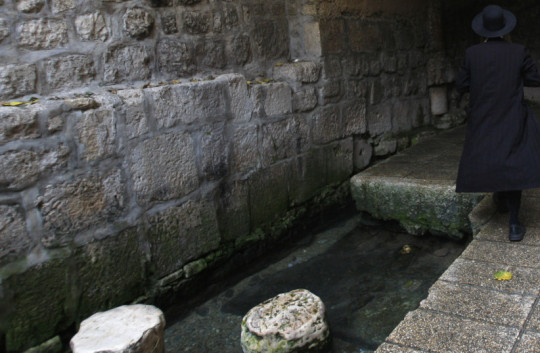
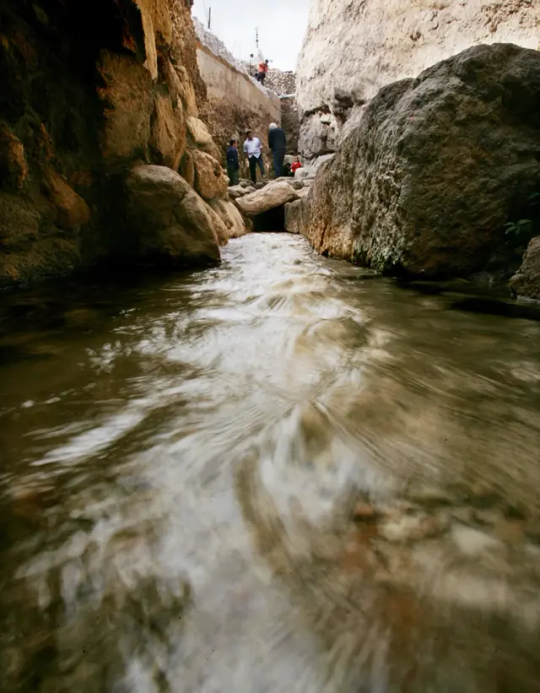
“The half-mile running through the City of David, from the Pool of Siloam in the south, continuing along the Pilgrimage Road, up to the footsteps of the Western Wall, Southern Steps and Temple Mount, represents the most significant half-mile on the planet,” Orenstein said.
“There is no half-mile anywhere on Earth which means more to more people – not to millions, but to billions — than the half-mile that is the City of David,” he added.
The pool was first built roughly 2,700 years ago as part of Jerusalem’s water system in the eighth century B.C.
The construction unfolded during the reign of King Hezekia as cited in the Bible in the Book of Kings II, 20:20, according to the two Israeli agencies and the City of David Foundation.
According to estimates, the Pool of Siloam passed through many stages of construction and reached the size of 1.25 acres.
According to a passage in the Gospel of John, Jesus restored the sight of a man born blind at the Pool of Siloam.
A small section of the pool, which has been fully excavated, has been accessible to the public for several years.
The vast majority of the pool is being excavated and will either be opened piecemeal or once the entire site is unearthed.

Rev. Johnnie Moore, president of the Congress of Christian Leaders, told Fox News Digital in January that, “In the Pool of Siloam, we find evidence of history preserved for us, revealed at just the right time.”
“Theologically, it affirms Scripture, geographically it affirms scripture, and politically it affirms Israel’s unquestionable and unrivaled link to Jerusalem. Some discoveries are theoretical. This one is an undeniable. It is proof of the story of the Bible and of its people, Israel,” he said.
A stroke of luck revealed the pool in 2004, when infrastructure work carried out by the Hagihon water company uncovered some of the pool’s steps.
The Israel Antiquities Authority, under supervision of professors Roni Reich and Eli Shukron, launched a survey.
As a result, the northern perimeter, as well as a small section of the eastern perimeter of the Pool of Siloam, were uncovered.
“Whether in the halls of the United Nations, ongoing efforts by Palestinian leadership, or on university campuses, Jerusalem’s Biblical heritage is under assault,” said Orenstein.
Orenstein noted that in few years time, visitors to the City of David will be able to witness the factual history for themselves and “see with their own eyes, touch with their own hands, and walk with their own feet upon the very stones their ancestors walked thousands of years ago, as they made their way to Jerusalem on pilgrimage.”
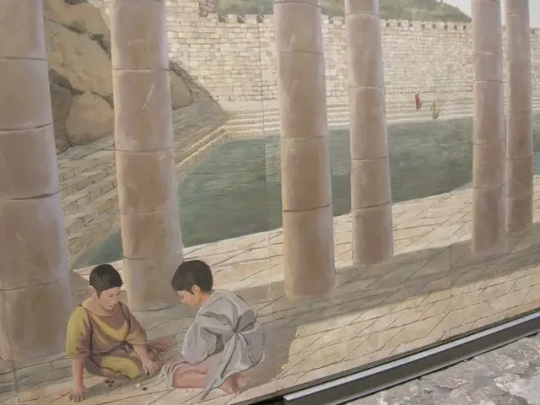
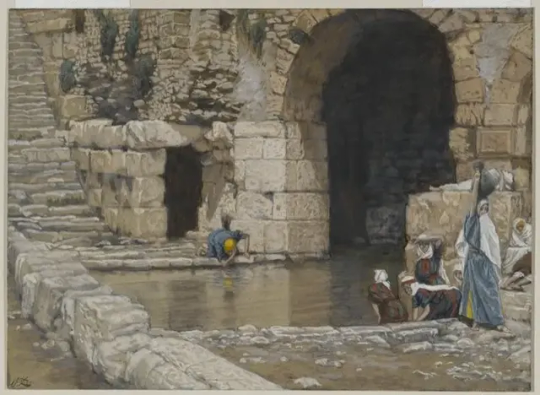
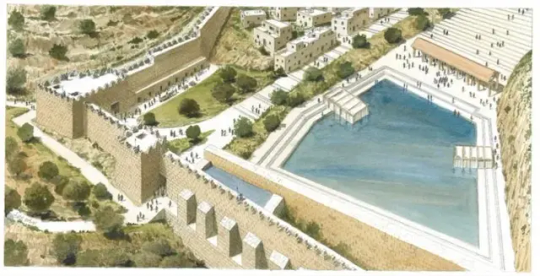
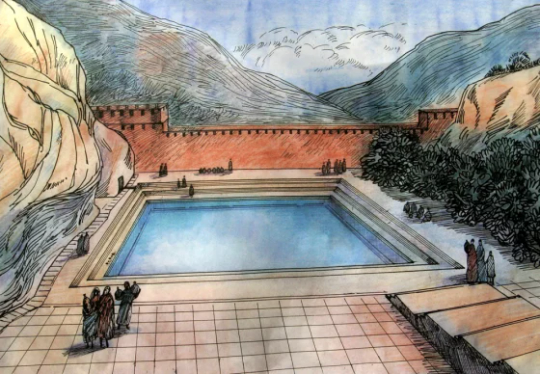
#Biblical Steps Where Jesus 'Healed a Blind Man' Unearthed by Archaeologists#Jerusalem#Israel#City of David#Pool of Siloam#Pilgrimage Road#King Hezekia#Jesus#Jesus Christ#ancient artifacts#archeology#archeolgst#history#history news#ancient history#ancient culture#ancient civilizations#ancient israel
130 notes
·
View notes
Text
The Reasonableness Theory of Good Omens

I’ve never done a Tumblr post before, but I’m going to have a go at it now, because the heaven/hell logics in the original Good Omens book (see also: the tv show The Good Place and also Terry Pratchett’s Discworld series generally) were foundational to the development of my theory of human behaviour – and I think it now explains A LOT about the Aziraphale/Crowley ending of Good Omens 2, and also what’s going wrong with us as a society.
So long story short – I’m a Cultural Studies academic at the University of Bristol, and I recently published a ‘smart thinking’ book called On Being Unreasonable: Breaking the Rules and Making Things Better (in bookshops now with Faber & Faber!). Here I explain how demands to “just be reasonable!” have been weaponised throughout history to halt social progress, from the suffragettes to Stonewall to the Civil Rights movement, up to the uproar over Black Lives Matter and Just Stop Oil protests today. Basically, what I think biblical-satire shows like Good Omens and The Good Place are satirising is exactly this: the inherent moral UNREASONABLENESS of the ‘reasonable person’, who wants things to be better but isn’t willing to break any rules to achieve it – even if those rules are bafflingly unfair and nonsensical (like the Job plotpoint, where Aziraphale began to realise this for the very first time).
When I say the ‘reasonable person’, I’m talking about the ‘moderate’ whom Dr Martin Luther King famously described in his Letter from Birmingham Jail as being almost worse than the ‘evil’ side of the out-and-out racist. This is the so-called ‘good’ side, who talk the language of progress whilst getting in the way of any attempt to realise it because they are “more devoted to ‘order’ than to justice”. In On Being Unreasonable I trace an overarching tendency to value the APPEARANCE of reasonableness (calm voices, shiny smiles, dapper suits) over the messy impoliteness of standing up and fighting back. In other words, rather than Heaven being the good guys and Hell the bad guys, Good Omens exposes how BOTH sides end up doing bad things because they’re unwilling to rebel against authority, break unjust rules/laws, and actually do what is RIGHT. We saw this especially clearly, I think, in the hell fire/holy water scene: one side might be ugly and the other side beautiful, but both sides are shown to be monstrous. “Just shut your stupid mouth and DIE already!” is still evil even though it’s said through a smile rather than a scowl.
This is where Crowley comes in. Crowley sees Heaven for who they really are. And this is why he resents being called ‘nice’ – because the qualities of niceness have historically been used as cover for tremendous evil – like how God’s ineffable command to kill Job’s children was morally horrifying, but how the Angels’ smiling promise to replace them with new children made a terrible thing seem like an act of divine grace. In many ways I’m saying nothing new here at all, I know – ‘omg the good side are actually the baddies! gasp!’ is hardly a novel literary interpretation. But it’s a bit more complicated than just that. What I’m talking about here is the specific sociopolitical mechanism by which reasonable appearances have been confused with actual moral goodness – and how this impulse to see ‘nice’ and think ‘good’ has historically been weaponised against us. It’s this that Good Omens really exposes. As I say in On Being Unreasonable, we can see this everywhere. “Think about the honeyed gentility of the American South, where smiling courtesy provided cover for simmering racial violence. Think about the buttoned-up laced-down aggression of the white imperial invader, sitting on their verandas in the Indian sunshine sipping tea. Think about the polished performances of the Nazis, with all their approving 1930s newspaper articles about impeccable manners and rarified tastes in art and dress”. In fact, there’s even an adjective for this: ‘Minnesota Nice’, which is often used as a backhanded compliment to refer to people who avoid confrontation in favour of a veneer of false politeness, and for whom calling out homophobia/racism/misogyny/etc is unforgivably rude. Nice, in this sense, can never be good, because it is being used to advance evil.
In Good Omens, what we saw is how deeply Aziraphale longs to break free from this logic, but how he can’t yet quite manage to free himself from that sense of reasonable idealism – the belief that surely the ‘good’ side of this broken system can be reformed from within. Meanwhile, Crowley is clearly being depicted as a fallen Angel in the true sense – someone who realises that the system itself is rotten to the core, and is willing to ask the hard questions and break rules in pursuit of truly moral actions, even if it costs him everything. Crowley has bitterly learned never again to make the mistake of confusing order with justice; this is a lesson that Aziraphale still needs once and for all to learn.
In the conclusion to On Being Unreasonable I set out a kind of matrix of behaviour to explain all this, where the Unreasonably-Unreasonable people are – like Hell! – “the deliberate contrarians and hate-speech purveyors and greed-is-good libertarian individualists, who think they can say and do whatever they want without consequences no matter the harm to anyone else”. Meanwhile, like Heaven, a lot of self-professedly progressive people seem to have become “so determined not to be like them that we’ve become something just as bad” – namely, Unreasonably-Reasonable people, “obsessed with tone-policing and respectability politics and endless toothless debate, happy to act the devil’s advocate and platform hate-speech and injustice so long as everyone appears to be doing it politely”. What I think we’ll see unfolding in Good Omens 3 is the revelation that what the world ACTUALLY, desperately needs is more people like Crowley, the Reasonably-Unreasonable people on whom social progress has always depended: “those who understand that civic dissent and smashing down racist statues and no-platforming bigots might sometimes be the only way to make the world a better place”.
So if God (and Neil Gaiman) really does have an ineffable plan then maybe it was this. Crowley needed to fall then, and Aziraphale needs to try to reform Heaven and fail spectacularly now, in order for us all collectively to rid ourselves of that morally-unreasonable urge to seem reasonable in the face of great injustice forever.

#good omens#good omens meta#aziraphale#aziracrow#crowley#good omens 2#neil gaiman#michael sheen#david tennant#ineffable husbands#good omens spoilers
101 notes
·
View notes
Text

Painting of the same title [Love Among The Ruins] , inspired by Browning's poem, by Edward Burne-Jones
+
Here. Have a poem. A beautiful poem. And read it, if you can make time, and if you can stretch your ever-shrinking attention span (like mine is). Not sure why this one today. Maybe because Jerusalem has risen to glory and fallen to desolation repeatedly. It has never been so populous with so many buildings and so much life. It doesn't seem possible it could be desolate yet again. But it probably didn't seem possible at any previous pinnacle either. It certainly didn't to the author of the biblical Lamentations, whose speaker stares in disbelief after its sack by Babylon, as they ask in the opening verse, How sits the city solitary, that was full of people. How is she become as a widow. She that was great among the nations, and princess among the provinces, how has been laid low.
Someday, maybe not all that far off, this place where I love, charmed as I remain by its layers of history and poetry, could resemble Browning's vision. Maybe our great edifices will greet people like broken Ozymandias as an unintended caution against arrogance and vainglory. Certainly enough of that to go around these days. Can it be avoided? Seems like that would be bold new territory for this city, and perhaps all humanity.
Or, maybe just because I love this poem.
+ Love among the Ruins ~Robert Browning
Where the quiet-coloured end of evening smiles, Miles and miles On the solitary pastures where our sheep Half-asleep Tinkle homeward thro' the twilight, stray or stop As they crop— Was the site once of a city great and gay, (So they say) Of our country's very capital, its prince Ages since Held his court in, gathered councils, wielding far Peace or war.
Now the country does not even boast a tree, As you see, To distinguish slopes of verdure, certain rills From the hills Intersect and give a name to, (else they run Into one) Where the domed and daring palace shot its spires Up like fires O'er the hundred-gated circuit of a wall Bounding all Made of marble, men might march on nor be prest Twelve abreast.
And such plenty and perfection, see, of grass Never was! Such a carpet as, this summer-time, o'er-spreads And embeds Every vestige of the city, guessed alone, Stock or stone— Where a multitude of men breathed joy and woe Long ago; Lust of glory pricked their hearts up, dread of shame Struck them tame; And that glory and that shame alike, the gold Bought and sold.
Now—the single little turret that remains On the plains, By the caper overrooted, by the gourd Overscored, While the patching houseleek's head of blossom winks Through the chinks— Marks the basement whence a tower in ancient time Sprang sublime, And a burning ring, all round, the chariots traced As they raced, And the monarch and his minions and his dames Viewed the games.
And I know, while thus the quiet-coloured eve Smiles to leave To their folding, all our many-tinkling fleece In such peace, And the slopes and rills in undistinguished grey Melt away— That a girl with eager eyes and yellow hair Waits me there In the turret whence the charioteers caught soul For the goal, When the king looked, where she looks now, breathless, dumb Till I come.
But he looked upon the city, every side, Far and wide, All the mountains topped with temples, all the glades' Colonnades, All the causeys, bridges, aqueducts,—and then All the men! When I do come, she will speak not, she will stand, Either hand On my shoulder, give her eyes the first embrace Of my face, Ere we rush, ere we extinguish sight and speech Each on each.
In one year they sent a million fighters forth South and North, And they built their gods a brazen pillar high As the sky Yet reserved a thousand chariots in full force— Gold, of course. O heart! oh blood that freezes, blood that burns! Earth's returns For whole centuries of folly, noise and sin! Shut them in, With their triumphs and their glories and the rest! Love is best.
(Ori Hanan Weisberg)
#Love Among the Ruins#Ori Hanan Weisberg#poetry#poem#words and writing#my favorites#reading and writing#Robert Browning
14 notes
·
View notes
Text

Older than Egypt is Ethiopia!
Ethiopia is old, even older than Egypt, but its
antiquity is somewhat different. While Egypt was the world's first indisputable nation-state, unique in its complex politico-religious system augmented by magnificent material remains and a corpus of epic literature, in Ethiopia, the very cradle of mankind, the material evidence of its ancient civilisation alone attests to its former glory.
The Ancient Egyptians, from the earliest times, kept records of their kings and this chronology is central to the chronological structure of the early Aegean, Levantine and Mesopotamian civilisations. It is, however, of no import to Ancient Ethiopia. If the
Ethiopians did keep records, these have either been lost for ever or not yet discovered. The attempts by unnamed writers to compile an Ethiopian king-list -- the Kebra Negast or Book of the Glory of Kings -- from
the Queen of Sheba to the rise of the Zagwe dynasty, is believed to be a 13th-century creation; its aim seems to have been to establish the political credentials of the so-called Solomonic dynasty, an Ethiopian king-list that traces the rulers of Ancient Axum to Menelik I (originally Bin Ha Malik, The King's
Son), the son of the "Israelite" King Solomon and the "Ethiopian" Queen Makeda, the Queen of Sheba.
Confusingly, the Queen of Sheba features prominently in the oral and written traditions of Ethiopia, Yemen and ancient Israel. The Yemenis saw her as a South Arabian queen, the Ethiopians as Axumite. In Arabic her name is Bilquis, in Ethiopia Makeda and in the biblical language of the Israelites she is known as
the Queen of Sheba. To add to the confusion,
historians suggest that King Solomon must have reigned around the 10th century BC. It is difficult to decipher fact from fiction, but archaeological evidence is indisputable and it reveals that Axum was founded a millennium later.
LUCY-DINKENESH: Ethiopia easily claims the longest archaeological record of any country
8 notes
·
View notes
Text
#Imam Mahdi#end time prophecy#bible prophecy#Islamic prophecy#biblical prophecy#Islam#muslim#king of the south
0 notes
Text
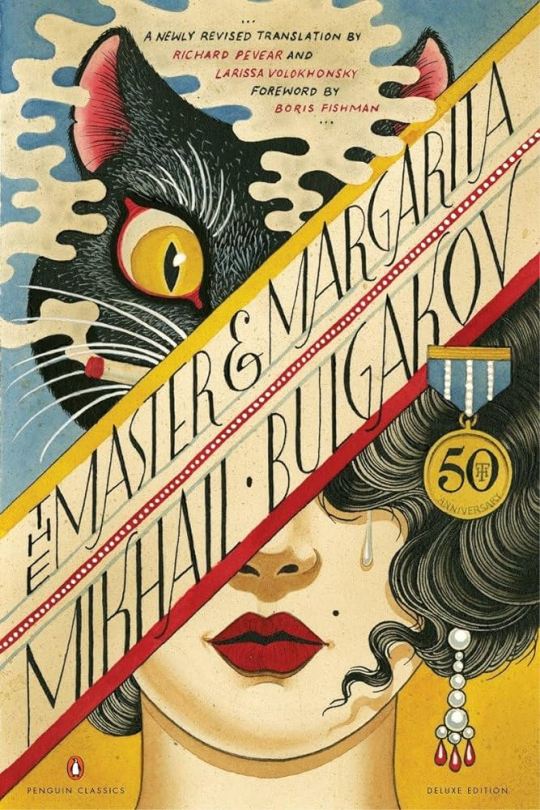
[REVIEW] The Master and Margarita by Mikhail Bulgakov
3/5 stars (★★★)
"He does not deserve the light, he deserves peace."
This was an oddly enjoyable read for the Christmas season. Before I read The Master and Margarita, I had zero idea what the book was about and 412 pages + a lot of reviews later I still can't exactly say what even happened here. The Gogolian influence was very persistent in Bulgakov's prose, so I highly recommend reading some of Nikolai Gogol's stuff before getting into TMaM. That being said, I agree with people that it's a novel that stands on its own in spite of its heavy context. I did some background research into Bulgakov's biography, the ten-ish years it took for him to write the book, Stalinist Russia, and the 25-year gap between when he finished the manuscript (which don't burn!) and the actual publication of it after his death. Critics seem to be unanimous in agreeing that the Master is a self-insert of Bulgakov himself, which I really felt to be most fitting during the scenes in the hospital where he discussed with Ivan the Homeless his philosophies on art and the current social order. I appreciated Bulgakov's harrowing criticism on Soviet Russia without actually being too grave about it; the dark humor is good because the "dark" is the adjective that informs the noun, not vice versa like a lot of "satire" plots which I feel fail in comparison. The magical realism was a good kind of wacky (although I wouldn't exactly call it magical realism, but that may be just because I'm more used to its South and Latin American literary uses). I liked Woland and all the beheading episodes. Bulgakov's tongue-in-cheek treatment of citizens "disappearing," private executions, political censorship of the Soviet intelligista, and the air of general repression felt in all people, especially artists, during the time were spot-on (though that's coming from someone who never experienced Stalinist Russia and have only done humble research into it). I think TMaM is a great testament to the political and social climate of Russia in the 20th century. Bulgakov captured everything so well whilst still retaining a sense of wonder, folkloric absurdism, and, at times, tender humanity.
Personally, I didn't like the scenes set in Yershalaim with Pontius Pilate and Yeshua Ha-Nozri, though I appreciate their symbolic meaning and narrative weight as a whole. I honestly found myself falling asleep, especially during the infamous conversation between Pilate and Jesus. That being said, I found Bulgakov's portrayal of Jesus very intriguing, as well as his decision to refer to ancient Jerusalem by an alternate transliteration from the Hebrew quite bold. It gave a sort of distancing effect to the otherwise well-known Biblical places that separated their religious (over)-associations with actual historic (and fictionalized) context. I like that Jesus became "Yeshua," with the name obviously coming from the Aramaic word for "the Lord is salvation." Bulgakov making Jesus' last name "Ha-Nozri" meaning "of Nazareth" specifically was quite beautiful to me, as it places him as coming explicitly coming from the town of Galilee (north of Palestine), which Jesus was said to have lived in before he began his ministry. Instead of "Jesus Christ" or "King of Israel," which are common ways he is referred to, Bulgakov opted to name him according to his native Palestinian roots first and foremost. There's a lot of literary analysis you can take from that, but it's inherently a very defiant decision that I appreciate Bulgakov for making, and I'm saying that as a reader in 2024. Bulgakov, amongst other subtle cultural references, also mentions the keffiyeh ("kefia") in his novel a handful of times, most strikingly in the scene when Matthew Levi essentially curses at God because he was too late saving Yeshua from crucifixion. Bulgakov here is writing almost 100 years ago from where I am with zero idea of the political climate happening now in my world (although Zionism was still obviously present in early 20th century Russia). Matthew Levi's keffiyeh was one of the book's most resonant images for me, even if Bulgakov didn't exactly intend it to be as jarring as it is since he couldn't have predicted the genocide happening in Gaza right now. However, this small link I've noticed between the past and now is just an example of literature transcending time and space by acting as a bridge for human connections. Long ago, one man from Palestine disrupted Jerusalem and Rome's established (tyrannical) order and then centuries later a writer in early 20th century Russia adapted Jesus' story to criticize the cruelties and ridiculousness of the Stalinist regime, and then I in 2024 am reading this as the mass killings are happening in Palestine. Through this one book, three generations -- three timelines -- are somehow connected.
My final comment is that TMaM, particularly that connection I've personally drawn as a modern reader, reminds me why humanities, reading, history, literature, the arts, etc. are so timelessly and universally important. I know I may sound crazy and "you're just trying to be deep," but it really honestly is the truth. Bulgakov explicitly highlighting Jesus as Palestinian in Soviet Russia as a form of political protest and me in 2024 reading this book just as Jesus' same homeland is being massacred during Christmastime ... it's so haunting. The book being finished in 1940, meaning it and Bulgakov's very Palestinian Jesus is older than the "state" of Israel is an even more damning fact in and of itself. Even though I gave the book 3/5 stars, it's surely a story I will remember. That final image of the four "horsemen" riding off into the distance just as another dawn is breaking over a dictatorial empire history knows is doomed to crumble that concludes the novel will stay with me.
#mikhail bulgakov#bulgakov#the master and margarita#russian literature#literature review#book review
6 notes
·
View notes
Text
Being Gay is African: A Historical Perspective
The assertion that homosexuality is a Western concept is a myth largely propagated by colonial influences and the import of Christianity. Historically, African cultures have recognized and included various forms of same-sex relationships and identities, which have only been obscured by later colonial and religious narratives.
Contemporary Conflicts and Historical Evidence
During his visit to Africa in 2015, US President Barack Obama highlighted the legal discrimination against LGBT individuals. In Kenya, he emphasized the importance of treating all individuals equally, irrespective of their differences. Kenyan President Uhuru Kenyatta responded by asserting that Kenyan culture does not accept homosexuality. This sentiment is not unique and has been echoed by other African leaders such as Robert Mugabe of Zimbabwe, Goodluck Jonathan of Nigeria, and Yoweri Museveni of Uganda. However, historical evidence contradicts these assertions.
Historical Examples of Homosexuality in Africa
Ancient and Pre-Colonial Evidence
Yoruba Language: The Yoruba language has a term, "adofuro," which describes someone who engages in anal sex. This term, which predates colonial influence, indicates an awareness of homosexual behavior.
Azande Warriors: In the 19th century, the Azande people of Sudan and the Democratic Republic of Congo practiced same-sex relationships where warriors would marry young men due to the scarcity of women. These relationships were socially accepted and included rituals and formal marriage customs (Face2Face Africa).
King Mwanga II of Buganda: King Mwanga II of Uganda openly engaged in homosexual relationships with his male servants before the advent of Christian missionaries who brought condemnation (JSTOR Daily).
Ancient Egypt: Paintings and records suggest that Nyankh-Khnum and Knum-Hotep, royal servants in ancient Egypt, may have had a homosexual relationship. These men were depicted in affectionate poses and shared a tomb, highlighting the acceptance of their relationship within their society (AfricaOTR).
Meru Community in Kenya: The Mugawe, religious leaders among the Meru, often dressed in women's clothes and married men. This role was not just accepted but integrated into the spiritual and social fabric of the community (AfricaOTR).
Anthropological Insights
Marc Epprecht, a historian, documents various forms of same-sex relationships across Africa that were ignored or misinterpreted by early Western anthropologists. These relationships ranged from love affairs to ritualistic practices. For example, among the Imbangala of Angola, same-sex relationships were part of ritual magic. Similarly, in South Africa, temporary "mine marriages" were formed among men working in mines during colonial times (JSTOR Daily).
The Influence of Christianity and Colonialism
The rise of fundamental Christianity, heavily influenced by American televangelists since the 1980s, has significantly shaped the contemporary African stance on homosexuality. Many Africans argue that homosexuality is against Biblical teachings, yet the Bible itself is not part of African historical culture. This adoption of a Western religious framework to argue against homosexuality demonstrates a significant cultural shift influenced by colonialism.
The Political Use of Homophobia
Populist homophobia has become a political tool in many African countries. Politicians gain votes by promoting anti-gay sentiments, creating an environment where hatred and violence against LGBT individuals are not only accepted but encouraged. This has led to severe consequences, such as corrective rapes in South Africa and oppressive laws across the continent.
Reclaiming African Heritage
To combat the dangerous narrative that homosexuality is un-African, it is crucial to retell and reclaim African history. African culture historically celebrated diversity and promoted acceptance, including various sexual orientations and gender identities. By acknowledging and teaching this true history, we can foster a more inclusive and equitable society.
Reaffirming our commitment to historical accuracy and cultural inclusivity is essential. True African heritage is one of acceptance and recognition of all its members, regardless of their sexuality.
5 notes
·
View notes
Text
Judaism: The Origin and Evolution of the Religion that Shaped Civilization

Judaism, one of the world’s oldest monotheistic religions, has played a pivotal role in shaping the cultural and spiritual identity of billions of people over the millennia. With roots dating back more than 3,000 years in the ancient Land of Canaan (modern-day Israel and Palestine), Judaism is not just a faith but also a rich tradition of laws, customs, history, and philosophy. This article explores the origin, history, and evolution of Judaism, highlighting its enduring influences on civilization.
The Origins of Judaism: Abraham, Isaac, and Jacob
The history of Judaism begins with Abraham, considered the patriarch of the Jewish people. According to the Torah, the main scripture of Judaism, Abraham lived approximately in the 19th century B.C. and is seen as the first to recognize a single God, Yahweh. Tradition tells that God made a covenant with Abraham, promising him that his descendants would be numerous and that they would inherit the Land of Canaan. This covenant was renewed with Isaac, Abraham's son, and with Jacob, his grandson, who later became known as Israel, the name that would give rise to the people of Israel. Jacob's 12 sons are considered the ancestors of the twelve tribes of Israel, which formed the nucleus of the ancient Jewish nation. ### The Exodus and the Giving of the Torah: The Making of a Nation
One of the most significant events in Jewish history is the Exodus, the liberation of the Israelites from slavery in Egypt, led by Moses around the 13th century B.C. According to the biblical narrative, Moses led his people through the Sinai Desert, where he received the Torah, including the Ten Commandments, on Mount Sinai. The Torah, which means “instruction” or “law,” contains not only religious guidelines but also moral and ethical principles that govern all aspects of Jewish life.
This event not only marked the birth of Judaism as an organized religion, but also cemented the concept of a people chosen by God, united by faith, law, and tradition. The Exodus narrative has become an eternal symbol of liberation and hope, celebrated annually at the Jewish Passover (Pesach).
Establishment and Fall of the Kingdom of Israel
After their period of wandering in the wilderness, the Israelites settled in Canaan, forming a confederation of tribes. In the 11th century BCE, the unification of these tribes under Kings Saul, David, and Solomon resulted in the creation of the Kingdom of Israel. Under Solomon's reign, the Temple in Jerusalem was built, becoming the spiritual and physical center of Judaism.
However, after Solomon's death, the kingdom split into two parts: the Kingdom of Israel in the north and the Kingdom of Judah in the south. This division weakened the Israelites, who were eventually conquered by foreign powers. In 586 BCE, Jerusalem was destroyed by the Babylonians, and many Jews were exiled to Babylon, marking the beginning of the Babylonian Exile.
The Exile and the Evolution of Judaism
The period of exile forced Jews to rethink their identity and religious practices. Without the Temple as the center of worship, Judaism began to focus more on communal practices and Torah study. This period saw the emergence of synagogues as places of prayer and teaching, and the development of oral traditions that would later be compiled into the Talmud.
After 70 years, many Jews returned to their homeland, and the Second Temple was built, marking a new phase in Jewish history. However, Judaism continued to evolve, with an increasing focus on scripture, prayer, and the development of a life based on religious law, which became known as Halacha.
The Diaspora and Rabbinic Judaism
In 70 CE, following a revolt against the Roman Empire, Jerusalem was again destroyed, and the Second Temple was razed. Without the Temple, Judaism was transformed, with the Rabbinate assuming a central role in spiritual leadership and the interpretation of religious law. Jewish life began to revolve around the synagogue and the home, with rabbis guiding Jews on how to live according to the Torah wherever they were in the world.
As Jews dispersed throughout Europe, the Middle East, and North Africa, Judaism developed diverse cultural and ritual traditions that reflected the different conditions of life in the diaspora. The Torah, Talmud, and rabbinic commentaries continued to be studied, debated, and reinterpreted, keeping Jewish identity alive despite persecution and expulsion over the centuries.
Influences on Civilization and Legacy
Judaism is often described as the mother of the Abrahamic religions, having directly influenced Christianity and Islam. The concept of ethical monotheism, the importance of social justice, and the idea that history has a purpose and destiny are all elements that originated in Judaism and were inherited by other religions.
Furthermore, the cultural impact of Judaism is immeasurable. Jewish tradition has valued education, writing, and the preservation of historical memory, leaving the world with a vast religious and philosophical literature. The concept of a weekly day of rest, Shabbat, is a Jewish contribution that has shaped Western civilization.
Judaism in the Modern World Today, Judaism continues to flourish with millions of followers around the world. Although there are diverse streams, such as Orthodox, Conservative, and Reform Judaism, they all share a common bond with the Torah and the rich Jewish cultural heritage. The creation of the State of Israel in 1948 marked a turning point in Jewish history, providing a national home for a people who had lived in diaspora for centuries.
In the contemporary world, Judaism continues to face challenges and adapt, maintaining its traditions while engaging with modernity. Their legacy is a testament to the resilience and adaptability of a faith that, despite its ancient origins, remains alive and relevant today.
Judaism, with its long and complex history, continues to be a living force that influences not only its followers but also global culture, morality and philosophy. The faith of Abraham, Moses and the prophets has survived empires and exiles, and its message of justice, faith and hope continues to resonate in a world still searching for answers to the eternal dilemmas of the human condition.
3 notes
·
View notes
Text
I wasn't one of those evangelical kids who got caught up in the emotions of the camp devotionals. I never really cared about the rapture, or death in general. Much less eternal life. The reason I stuck around all the way through college was because I trusted the family and friends who taught me all the bible stuff. They always told me not to trust them, so that one's on me.
They always said, "Don't take my word for it, read the scripture! Do your own studying!" I said to myself, "yeah yeah, cool. In theory. I can't read aramaic or ancient greek though, and I don't really want to spend years in school learning that. It's much more practical to have all these people I know I can trust because they're such good people who clearly have my best interests at heart."
Then I went to a bible college. For an art degree, but they still made me take a bible class every semester. Between meeting esteemed bible scholars and historians in universities on the other side of the world who did know ancient greek aaaaaaand becoming distanced from my old communities, I finally did what they'd always told me to do: I did my own studying. I never learned much ancient greek but learning how to do academic research helped a lot.
Wouldn'tchaknowit—my findings vastly expanded my knowledge from what I'd been taught as a kid. At that point in my early 20's I didn't feel betrayed. What I thought I'd discovered were earnest mistakes! An honest lack of understanding from folks who hadn't had the privilege of traveling and studying the way I had. I was happy to bring what I'd learned back home to them, and embark on new adventures in learning together.
Only one... little... problem. Turns out none of them wanted that.
They didn't want to hear about the fascinating history of biblical mistranslations or cultural analysis of American evangelicalism and how it relates to feminism. They didn't want to learn about the history of other world religions like Buddhism and the interesting parallels with Abrahamic religions. They didn't want to believe queer people aren't explicitly condemned by scripture or that the 2000 year old book they worship might not actually contain a fail-safe blueprint for life in the 21st century. They didn't want think about how much of the bible might've been tacked on by scholars & kings who used it as a tool for social control. I still believed in god and called myself a Christian at this point, after all that. I lost my faith in the people first. I opened my eyes and saw it all. I saw too much.
Any time I tried to share what I'd learned or gently push back against their teachings their condemnation was immediate and absolute. It quickly became clear that what 'studying scripture' meant to them was only ever, "we'll tell you what it means, and you'll believe us." Any deviation from their 'interpretation'—now plainly revealed to me as patriarchal 1950's American traditionalism dressed up in middle eastern farmer's robes and doing a VBS play production of an ancient culture they knew frighteningly little about—only branded me as a disrespectful dissident. I also saw Christians I'd respected doing all manner of dishonorable things. A missionary who'd once nearly convinced me to work with him in South America sent me a horrifically islamophobic manifesto. Church elders admitted to me that they owned city slums. Outwardly perfect couples filed for divorce. Bit by bit it wore down my trust. It broke the illusion that Christianity offered any kind of exclusive merit or made anybody better somehow. I started to realize they were all just as flawed and fallible as any 'sinner' off the street. Of course they were all quick to say 'we have all fallen short of the grace of God!'—but what's the point, then? These people I'd trusted with my soul were quick to admit that they shouldn't be trusted... then turn around and insist that they still knew what was best for me and my life.
Over the next few years it got to the point that they as good as told me to my face that the only way I could keep being part of their community was if I shut up and conformed to exactly what they believed. I almost could've put up with it except that that tacitly included being good christian wife with 2.5 kids who votes republican, lives in the suburbs, and goes to Wednesday night bible study to listen to some local septuagenarian who never set foot in seminary school teach me a moral lesson from the same damn book every week.
Like hell.
It became painfully clear they'd never truly cared about what was good for me or what would actually make me happy. Once I realized the horrible truth of my situation I only stuck around so long because I didn't want to rock the boat. I always liked the singing, and the sexist jokes from the pulpit were a decent conversation starter for whenever I wanted to try another assault on the fortress of my parents' ignorance. One day during Sunday morning song service my dad saw me reading a book in my lap. He leaned over and angrily said, "If you're only here for me, don't bother." So I stood up and walked out.
Never been back.
God and I were always chill, from the start to the end. We get into some heated moral arguments and sometimes we debate whether gods even exist, but what else are gods for? It's the worshipers who worry me.
#I said peace out#imma go#ex evangelical#I'm sure I've told this story before#but it's on my mind again#personal problems#save me from my family#no contact#evangelical christianity
7 notes
·
View notes